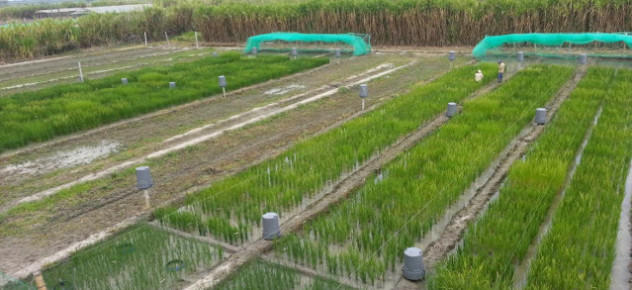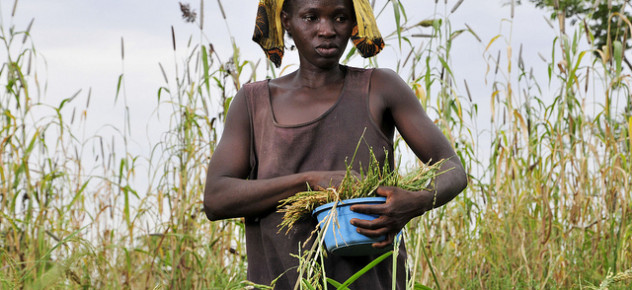
Screening of transgenic rice lines in confined research facilities at CIAT headquarters in Colombia. The lines contain three genes that together contribute to more efficient use of nitrogen and water as well as tolerance to saline soils. Credit: CIAT
In keeping with longstanding CIAT policies on genetic transformation, Center scientists lent their support this year to demonstrating proof of concept for transgenic rice lines being developed for sub-Saharan Africa. The new lines contain three genes that together contribute to improved uptake of nitrogen from the soil, more efficient use of water, and increased tolerance to saline soils.
Referred to as NEWEST rice (for nitrogen use efficient, water use efficient, and salt tolerant), the “triple-stacked” lines have resulted from a program begun in 2008 to improve NERICA (New Rice for Africa) varieties. These varieties are interspecific hybrids developed by the Africa Rice Center, with the aim of combining the high yields of Asian rice (Oryza sativa) with insect resistance and other traits from African rice (O. glaberrima), which are essential for adaptation to growing conditions in the region.
‘Nitrogen-Use Efficient, Water-Use Efficient and Salt Tolerant’ NEWEST #rice project progress report 2012 #AATFAfrica http://t.co/y62ekDbMNW
— knowledge.cta.int (@Knowledge4Dev) March 11, 2013
NERICA variety seed has been widely distributed in Africa and is now sown on hundreds of thousands of hectares in several major producing countries, notably Côte d’Ivoire, Guinea, Nigeria, and Uganda. While representing a major advance, the resulting gains fall short, however, of the large increases needed to reduce the continent’s burden of rice imports. According to the Food and Agriculture Organization of the United Nations (FAO), rice is Africa’s fastest growing food source. And while African farmers produce 12.5 million tons of milled rice annually, there is still a deficit of 12 million tons, which countries import at a cost of US$5.7 billion.
Clearly, Africa’s smallholder rice growers need varieties that are even more productive and eco-efficient in the face of growing demand, climate change, and other pressures. Experimental results obtained so far from several African countries, in consultation with the national biosafety committee of each country, show that the transgenic NEWEST lines use soil nitrogen more efficiently than non-transgenic control lines, resulting in higher yields, even with lower doses of nitrogen fertilizer. Through field trials to be conducted over the next 4 years, researchers will also evaluate the salt tolerance and water-use efficiency of the NEWEST lines.

African farmers produce 12.5 million tons of milled rice annually, but there is still a deficit of 12 million tons. Credit: Neil Palmer / CIAT
CIAT has contributed to this work by screening the improved lines in its confined research facilities at Center headquarters in Colombia and by identifying the best performers in terms of nutrient-use efficiency for field trials in Africa. Our researchers will continue to evaluate NEWEST rice over the next 3 years in full compliance with Colombian biosafety regulations, with the aim of identifying elite lines for deployment in Africa.
“The development of NEWEST rice marks a major scientific milestone,” said Michael Selvaraj, a crop physiologist at CIAT. “Multilocation field trials conducted across countries will help us provide proof of concept for these interesting NEWEST genes and select promising transgenic lines for Africa’s smallholder rice farmers.”
In this research, CIAT is working in partnership with the African Agricultural Technology Foundation (AATF), Arcadia Biosciences (the US-based company that is the project’s product development partner), Public Intellectual Property Resource for Agriculture (PIPRA), and national agricultural research organizations in Ghana, Nigeria, and Uganda.
“In CIAT’s crop research, we resort to genetic transformation only when conventional breeding shows little promise for solving particular problems,” said Joe Tohme, director, of the Center’s Agrobiodiversity Research Area. “This is certainly the case with transgenic NEWEST lines, which have potential for adding value to conventionally bred NERICA rice.”